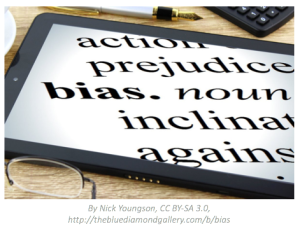Public Health Needs to Decouple Weight and Health
What are the issues?
Public Health’s focus on “obesity” prevention has increased exponentially within the last few decades, and with it an increase in weight stigma and negative attitudes towards people in larger bodies. In the past decade, weight discrimination has increased by 66%, and is one of the only forms of discrimination actively condoned by society. Decades of research have shown that experiencing weight stigma increases one’s risk for diabetes, heart disease, discrimination, bullying, eating disorders, sedentariness, lifelong discomfort in one’s body, and even early death.
Additionally, “obesity” related public health approaches can be harmful because they are based on limited or poor quality evidence, they focus on preventing one outcome at the expense of another outcome, they lack community engagement and they ignore the root cause of problems. However, the public health field has not taken a critical look at this research, focusing on the narrative that weight is controllable and a personal responsibility. If the goal is to find the most ethical and effective strategies to achieve optimal public health, there needs to be an alternative to “obesity” and weight focused approaches and a shift in understanding of weight stigma as a social justice issue.

11 reasons why we should not use weight-based approaches to health
1. The focus on body size is rooted in racism.
Around 81% of societies historically have favored people in larger bodies. Larger bodies signified wealth and prosperity while thinness signified poverty and weakness. However, this began to change due to racism and eugenics. Charles Darwin and other race scientists created a hierarchy of civilization, placing white men on top and people of color, specifically black people, at the bottom, considering them to be “less civilized.” Fatness and differing body characteristics were used to justify lack of civilization- fatness used as a marker of “uncivilized behavior” while thinness was “more evolved”. This idea was maintained throughout the United States in the 19th and 20th centuries, as a way to justify slavery, racism and classism, and control women through “temperance”. This ideology has perpetuated Desirability Politics- where thinness and whiteness are given more access to social, political and cultural capital.
2. The BMI is flawed (and you can’t tell someone’s health by their body size).
The BMI was developed by Adolph Quetelet in the 1830’s, with the goal of finding the “perfect human.” Quetelet was not in the medical field and did not intend for the BMI to be used for medical purposes. His sample population only included white French and Scottish men, thus, the BMI is not representative of the entire human population. It rose in popularity in the early 20th century when it was discovered by life insurance companies, who used it to set insurance premiums for their clients. The company found a relationship between weight and mortality, though the sample included only insurance company clients who self-reported their heights and weights. Nevertheless, it set off an interest in the use of the BMI as a tool to assess health. The BMI was determined to be the best tool to assess health not for its accuracy, but for its ease of use in medicine and research. The BMI does not consider health behaviors (e.g. stress, nutrition, physical activity) or body composition (e.g. bone, muscle, and fat mass). Therefore, it does not give an accurate picture of health.

3. Focusing on weight underdiagnoses thin people and misdiagnoses larger people.
A study of 40,420 U.S. adults using National Health and Nutrition Examination Survey (NHANES) data from 2005-2012 looked at health stratified by BMI and found: Nearly half of overweight individuals, 29% of obese individuals and 16% of obesity type 2/3 individuals were “metabolically” healthy
Over 30% of normal weight individuals were “metabolically unhealthy.”
If extrapolated to the US population, an estimated 74,936,678 US adults are misclassified as unhealthy or healthy if based on BMI alone. Another analysis of NHANES data showed that those in the overweight BMI category actually have the greatest longevity out of any BMI group, again contradicting the idea that BMI directly indicates health status.
When the medical system uses BMI as a health indicator, it can lead to misdiagnosis for people in larger bodies- with the risk of real medical concerns being overlooked as the focus is placed on weight or weight loss. Similarly, people in thinner bodies are often underdiagnosed due to an assumption of good health.

4. Evidence shows that diets don’t work and weight loss research is problematic.
Short term weight loss studies indicate that participants lose ~5-10% of their baseline weight. However, long term studies indicate that regardless of initial weight loss, most people regain that weight after 2 years, with up to 2/3 of dieters likely to regain more weight than they lost on their diets. Intentional weight loss has a 90% failure rate (5). If it were any other drug, it would never be considered for use.
In addition, much of the weight loss data is flawed with many studies featuring: High attrition rates (up to 70%) that often are not reported. Much of the obesity research in the U.S. is funded by weight loss and drug companies, such as Weight Watchers and Abbot Laboratories- thus influencing the types of studies that are funded and published.
Multiple interventions (e.g., diet, exercise, smoking cessation) or rigorous (not realistic) interventions Short study length (many studies only last ~6 months)

5. Food restriction is harmful.
Food restriction (via intentional weight loss) has detrimental effects on our physiology. Our bodies, designed to keep us alive at any cost, do not understand the societal importance of dieting. Rather, our bodies interpret food restriction as starvation, and adapt resiliently to keep us from losing important stores. When we restrict food, we weaken our body’s natural hunger and fullness cues, making us more susceptible to outside food cues. In addition, our body’s hormones change in attempt to reduce weight loss, producing more hormones that make us feel hungry and increase our cravings for carbohydrate foods, and less hormones that make us feel full.
Ancel Keys’ Minnesota Starvation Experiment found that men who spent 3 months on a semi-starvation diet (1700 kcal/day) had (15): significant decreases in strength/stamina, body temp, heart rate, sex drive and mental ability, increases in fatigue, irritability, depression and apathy, obsession with food (dreaming/fantasizing about food, reading and talking about food nonstop)
6. Weight cycling is bad for our health.
People who are dieting often experience weight cycling: the repeated loss and regain of weight. Weight cycling is associated with increased all-cause mortality, mortality from cardiovascular disease, risk for heart attack, stroke, diabetes, high blood pressure, and suppressed immune function.
Weight cycling is more commonly seen in people in larger bodies, due to the societal expectations that they lose weight or be “working on their health.” Despite weight cycling’s detrimental effects on health, it is often not considered as a confounding factor in research that investigates the relationship between body size and health. Therefore, it is hard to say for certain whether worse health outcomes in larger-bodied people are due to weight itself, or due to confounders such as weight cycling.

7. Rates of eating disorders/disordered eating are increasing (and it’s becoming normalized).
Dieting is a strong risk factor for disordered eating and eating disorders. Disordered eating differs from an eating disorder in that it does not have a diagnosis. However, both disordered eating and eating disorders can have profound negative effects on mental and physical health.
Disordered eating is defined by characteristics such as:
-
- Frequent dieting, including fasting, chronic restrained eating, restricting major food groups, bingeing, and/or using vomiting and laxatives Anxiety associated with specific foods or feelings of guilt and shame associated with eating
- Chronic weight fluctuations
- Rigid rituals and routines surrounding food and exercise
- Preoccupation with food, weight and body image that negatively impacts quality of life A feeling of loss of control around food, including compulsive eating habits
- Using exercise, food restriction, fasting or purging to “make up for bad foods” consumed
- 68% of Americans have dieted in some form. 65% of American women ages 25-45 have disordered eating, and 10% have a diagnosed eating disorder.
U.S. children are 242 times more likely to have an eating disorder than Type 2 Diabetes, and by age 9, 50% of girls have considered restricting food.
People of color experience eating disorders such as bulimia and binge eating disorder at higher rates than their white counterparts, often as a mediating factor from experiencing racism or other acculturative stressors. However, they are more likely to be underdiagnosed, which can occur due to misconceptions about who gets eating disorders. LGBTQ+ individuals also have higher rates compared to cisgender, heterosexual individuals, most likely as a way to mediate stressors.
8. Weight stigma is harmful to health ( and not controlled for in research).
Weight stigma is the discrimination or stereotyping based on a person’s weight. It is reported at rates comparable to racism and is one of the last types of discrimination still condoned and carried out by public health and medical experts. The incidence of weight stigma has increased by 66 % with the rise of public health campaigns to end the “obesity epidemic.”
Examples of weight stigma include:
-
- Receiving negative comments or ” health concerns” about your weight from anyone, including health care professionals Complimenting someone on their weight loss
- Receiving poor treatment because of your size or being denied/ required to lose weight because of your size in order to receive a medical treatment
- Not having comfortable chairs, airplane seats, etc.
- Weight stigma is a risk factor for: inflammation, stress, and high blood pressure Increased blood sugar and risk of Type 2 Diabetes
- Depression, anxiety, lower self-esteem, & higher body image dissatisfaction
- Disordered eating behaviors, eating disorder symptoms, and weight gain
- 7 out of 10 larger-bodied patients report having experienced weight stigma from doctors
Experiencing weight stigma not only increases one’s risk for negative health outcomes, it also leads to health care avoidance by people in larger bodies, increasing the chances that they do not receive preventative care services ( e. g. cancer screenings).
In children, weight-based bullying is one of the most frequent types of bullying experienced in school. Often, this type of teasing is a stressor children will face for years, throughout their childhood and into adulthood. Experiencing weight-based bullying often leads to coping though avoidance of physical activity and increased emotional or binge eating.
9. When we focus on weight, we’re not being trauma-informed.
Rates of eating disorders are often higher in people who have experienced trauma or Post Traumatic Stress Disorder (PTSD). People who have experienced trauma may use food as a safe and secure coping mechanism, both to distance themselves from unsettling thoughts or to reduce their attractiveness as defined within a society that equates thinness with beauty.
Assessing the relationship between eating and trauma is essential.
10. Higher weight is not causal to worse health outcomes.
Overall, there is a correlation between higher BMI and worse health outcomes, yet this does not imply causation. Research studies exploring this relationship should be assessed not only for quality in terms of study length and attrition length, but also whether they evaluate confounders including weight cycling, weight stigma, and trauma, factors often experienced by folks in larger bodies and which can have considerable impacts on health outcomes.

11. Focusing on weight ignores systemic injustices.
Though lifestyle factors such as nutrition and exercise are important, it is essential to note the historical racism and injustices within our current food environment. As presented by Soul Fire Farm, the U. S. food system is built on stolen land using stolen labor from black and latinx indigenous people. Not only has this created a large-scale food apartheid and trauma for people indigenous to this land, but it has also caused a disconnection of indigenous people from their cultural practices and identities
Appreciate that bodies come in all different shapes and sizes, and that fat people can be just as healthy as thin people. Remember, you cannot tell someone’s health on the inside by looking at their size on the outside. It is the responsibility of those in public health to create environments for every person to thrive in whatever body they live in.
Use a Health At Every Size (HAES) approach.
When we call for weight loss, we shift blame onto individuals and make health and weight a “personal responsibility,” when often they are the result of uncontrollable genetic or environmental factors. The HAES approach rests on the evidence that while extremes of weight and health problems are correlated, evidence for the role of factors other than weight in people’s health is stronger.
- Focus on root causes of health and social determinants of health, to develop long-term, sustainable solutions to improved population health.
- Where possible, work to increase health access, autonomy, and social justice for all individuals along the entire weight spectrum. Trust that people move toward greater health when given access to stigma-free health care and opportunities (e.g., gyms with equipment for people of all sizes; medical facilities that do not weigh patients).
- Weight is not a behavior. Focus on behaviors that impact health, such as eating, movement, stress management, sleep, smoking cessation, etc.
- Don’t moralize foods (e.g., “You need to stop eating X”). Instead, promote eating for pleasure, hunger, satiety and nutrition, not weight. Evidence shows that people who eat more intuitively eat more nutritious foods and keep their weight more stable over time.
- Promote mindful movement focused on what brings people joy and connection, not weight loss. A meta-analysis of 16 studies found that regardless of BMI, mortality indicators improved with exercise, indicating that movement can be healthy without a goal of losing weight.
- Critically evaluate the evidence for weight loss treatments and incorporate sustainable, empirically supported practices into prevention and treatment efforts. Call for more research where the evidence is weak or absent.
- Have discussions about fatphobia and weight stigma in your classroom and in your research. Engage students and researchers in critical thought about how to best measure health, without using weight as a marker, and how using weight as a marker of health can be harmful.
So where do we go from here? Consider…
What language do you use?
The term “obesity” is extremely stigmatizing. Instead, use terms such as “people in larger bodies.”
How does fatphobia show up in your classroom?
- Replace assignments connecting “obesity” and health or that focus on weight loss.
- Use weight loss research as a tool to think critically about what counts as good research to use when developing public health interventions. Consider: Who is most harmed by the use of BMI? How do racism, capitalism, and the use of BMI intersect? What would it look like to center the dignity, safety, and needs of fat folks in health interventions instead? Instead, have students explore other ways to promote health that are not focused on weight and are inclusive of all communities.
- Use research that isn’t rooted in fatphobia. Research may be fatphobic if it uses BMI as a marker for health, does not critically assess the role of confounders such as weight stigma, weight cycling, or trauma, has a goal of working to reduce the “obesity epidemic” or regards weight as a personal or moral responsibility.
Examples of Fatphobia in Public Health:
- BMI report cards in schools
- “Anti-Obesity” Campaigns
How does fatphobia show up in your research?
- Stop using BMI in research or contributing to/funding research that is fatphobic.
- Consider a broad range of research about the impact of weight on health when forming a research question. Public health interventions focused on weight loss are often rooted in shame, rather, use your research to explore interventions that are uplifting for all people and inclusive of all body sizes.
- Are you using BMI to look for differences in health? Unless you are using weight to dismantle fatphobia, consider using a different marker to indicate health.
- Ensure that you are creating an environment that is safe for fat folks. Do you have equipment like blood pressure cuffs or chairs that are comfortable for people in larger bodies? Are you requiring people to be weighed or report their weight?
- Consider how these aspects may be harmful or stigmatizing to people in larger bodies. Are you creating situations where fat folks are able and encouraged to participate in the study?

How does fatphobia show up for you internally?
- Explore your own internalized fatphobia. What biases do you have towards your family, friends, colleagues or students who have larger bodies?
- What types of conversations do you have with your family, friends and colleagues about body size, dieting, or what being healthy looks or acts like? Do they prioritize thinness?
- When you speak about your experience with the BMI or your body, are you looking for reassurance that you’re not fat?
- If you live in a thin body, consider the privileges this brings. Keep in mind intersectionality, and how other identities such as race and ability may play a role in the oppression of bodies. How can you be a better advocate for people in oppressed bodies?
Test Your Understanding
Pause to Reflect
This is a small group exercise meant to help students develop the skill of choosing textual evidence to support their claims (“claims” is another way of referring to thesis statements). Suggested Groupings appear in parenthesis within the student’s essay.
With your small group:
- Read the student’s essay below, What Obesity Has to do With the Female Sex.
- Identify the strengths or weaknesses of the student’s choice of quote. How well does the quote help the student to prove their point?
- Comment on the student’s topic sentence and overall control of the structure of the body paragraph: does the topic sentence need to be made more specific? Is the body paragraph well constructed?
What Obesity Has to do With the Female Sex
As food gets more processed and fatty, more people’s weight starts going up on the scale at doctors’ offices. However, is it lifestyle or processed food that is causing the weight gain? The answer may be surprising, as gender (sex) plays a significant role in the obesity crisis. It has been proven that biological women are more vulnerable, and play a bigger role in this ongoing epidemic due to a wide variety of biological and cultural factors.
FIRST: Let’s revise this thesis by answering the question, “How does gender inequality make women sick?” : Women are more vulnerable to the medical and social harms of obesity due both to biological and cultural factors.)
(Group 1)
As stated before, women statistically are more inclined to develop obesity. According to Allision Aubery, a journalist for npr.org, “Across all adult age groups, about 38 precent of women are obese, while only 34 precent of men were obese. Study author and CDC epidemiologist Cynthia Ogden says these gender differences are a new development.” This shocking percentage not only shows that women are more inclined to be obese, but are 4% more likely to face that hardship then the male gender. Looking at it from a larger perspective, there are hundreds of millions of people in the United States alone, so four percent means numbers in over the ten thousand margin – this is something people lack to consider when looking at the statistics that women are more at risk compared to men. However, this does not include the racial divide where the obesity in women skyrocket in percentages. The author states,”The obesity rate for women among African American women is 57 precent and 46 precent among Hispanic women.” (Aubrey). In most cases, minorities such as African American and Hispanic populations face poverty and a lack of proper food and specialized women’s health care.Although this does dive into the impact of minorities and those under the low income class, it is still relevant because these are still women who are forced to fight through the epidemic while not having the proper resources. Overall, these statistics are not only supportive towards the idea that being a biological female has a greater role towards weather or not someone has a greater risk of being considered overweight (or obese).
(Group 2)
Now that it is known how the sex of an individual impacts risk of becoming obese, there are three main vairables known to lead to this. The first of the three is the genetic makeup of the
female body. Research shows, “…the biological factor of menopause affects fat distribution that may increase risk or exacerbate negative effects of obesity on health…” (Kanter/Caballero). This means that once a female hits menopause, the horamonal changes impact weight fluxations, although lifestyle and inherited genetics can also play a role. During this changing time, the female body stops producing as much estrogen due to the ovaries having stopped producing eggs. This major drop in estrogen is a key link to weight gain.
(Group 3)
Another interesting factor regarding genetics is the overall process of metabolism and how the way a human processes food can differ between the sex’s. Jenny C. Link, and Karen Reue, also from the National Library of Medicine, provide a diagram explaining how each sex processes thier food intake. The diagram shows that women have a higher fat mass percentage while men have a higher percentage of lean mass. This information shows that women process (metabolize) food into more fat compared to men. The excessiveness of body fat is what obesity is defined as. The fact that women are more inclined to produce fact versus lean mass because of need for breasts (to feed newborns), and to outline intimate areas (for attraction of the opposite or same sex) means a higher risk to being either overweight or obese.
(Group 4)
The second main variable that can lead to obesity in women is birth control; more specifically the Depo Provera shot. This is a hormone based birth control that is injected into the arm every three months at local doctors offices. Birth control in itself, is a controversial topic, however looking from a medical standpoint, the purpose is to delay ovulation (keeping an egg from releasing) thus decreasing the risk of pregnancy.
(Group 5)
Although it is beneficial, there are side effects explored in an article from Yale Medicine by Carrie Macmillan. Macmillan quotes Dr.Stanwood, A lead professional at Yale Medical Center, “Patients often tell me that they think all birth control causes weight gain, but there is only one method, the progestin hormonal injection given every three months, that is linked to weight gain,” (Macmillan). Macmillan proceeds to back up Stanwoods claim by explaining, “…over one year, women who used Depo-Provera gained five pounds more than those using a copper IUD.” (Macmillan). The increase of weight is due to the fluctuations of hormones that are being injected into the body. The increase in estrogen during what is supposed to be ovulation, sends signals to a woman’s brain to eat more so as to store nutrients (fat) that would help the development of the fertilized egg. This means, a woman who is on birthcontrol and therefore cannot conceive, cannot fully use the nutrients stored for the expected pregnancy.
Birth control is something typically accepted by most in modern America (there are some exceptions from this of course). This acceptance, and sometimes even pressure from society leads women to this path ultimately increasing their chances of obesity compared to others.
The third, and final variable is something that most women experience in life, childbirth. Esa M Davis, and others from the National Library of Medicine write, ”The five-year risk of developing obesity for women giving birth to at least one child was 3.5 times that of women who had never given birth…” (Davis et al). The Article continues, “[The]National Longitudinal Survey of Youth cohort showed that only 11% of women with a normal pre-pregnancy BMI who become obese postpartum returned to a normal pre-pregnancy weight; 89% remained significantly overweight (BMI > 27) and obese in the 5 years after childbirth.” (Davis et al). Pregnancy is known to cause long term changes to the female body, as after birth it often takes weeks for a system to clear of all its hormones, hormones that oftentimes lead to greater appetite. It is also important to note as well that postpartum depression is also a major element that can lead to higher food consumption. Eating more foods, and feeling drained with a crying child leads to less activity, this leads to additional weight gain including that additional gain of fat from the pregnancy itself. All of this would explain why 89% of women who have had a child might experience being overweight.
It seems clear,given the research,to conclude that gender plays a significant role in the obesity epidemic for women. The cultural expectation of birth control among women, giving birth to continue the human race, and simply just having a different genetic make up then men, leads to a special vulnerability for women to fall victim to the obesity crisis.
Works Cited
Aubrey, Allison. “More Women than Men Are Obese in America, and Gap Is Widening.” NPR, NPR, 13 Nov. 2015, https://www.npr.org/sections/thesalt/2015/11/13/455883665/cdc-more-women-than-men are-obese-in-america-and-gap-is-widening#:~:text=Across%20all%20adult%20age%20g roups,differences%20are%20a%20new%20development.
Davis, Esa M, et al. “Childbearing, Stress and Obesity Disparities in Women: A Public Health Perspective.” Maternal and Child Health Journal, U.S. National Library of
Kanter, Rebecca, and Benjamin Caballero. “Global Gender Disparities in Obesity: A Review.” Advances in Nutrition (Bethesda, Md.), American Society for Nutrition, 1 July 2012, https://www.ncbi.nlm.nih.gov/pmc/articles/PMC3649717/.
Link, Jenny C, and Karen Reue. “Genetic Basis for Sex Differences in Obesity and Lipid Metabolism.” Annual Review of Nutrition, U.S. National Library of Medicine, 21 Aug. 2017, https://www.ncbi.nlm.nih.gov/pmc/articles/PMC5759759/.
MacMillan, Carrie. “What Birth Control Is Best for Me?” Yale Medicine, Yale Medicine, 22 Aug. 2019, https://www.yalemedicine.org/news/best-birth-control-options.
When you debrief from this exercise as a class, focus on the difference between a paragraph that informs the reader about facts relevant to the topic and a paragraph that provides concrete examples/evidence of the thesis statement. The takeaway from this exercise is likely that the quotes themselves must not be simply information relevant to the subject matter of the paper (information about birth control, for example) but specific ways that the thesis statement is true.
It is likely that the student who wrote the above paper wrote descriptively instead of analytically because they struggled to identify ideas to support their thesis. How do you come up with more ideas for supporting points/paragraphs? Here is a list of commonly used angles/issues:
- What is causing this?
- Why are women more vulnerable to the medical and social harms of obesity due both to biological and cultural factors?
- What are the beliefs and structures that enable this?
- What are the effects of this?
- What are the health/mortality/identity implications of women being more vulnerable to the medical and social harms of obesity?
- How is time relevant to this?(time period, historical comparison, or looking out over the next 5-10-20 years etc).
- What was this problem like 100 years ago? 50? 20? 10? What is the trend expected to be moving forward?
- How is space relevant to this? (geography, nationality)
Are American women (or Northern/Southern, older/younger, white/black, rich/poor, able/disabled women) more or less likely to experience this phenomenon?
- Get more detailed/specific with examples
Give case study details that provide real-world examples of how this issue expresses itself: what does it mean, exactly, for women to be impacted medically? Socially?
- Get more general/abstract on the level of theoretical implications/what is known on the subject
How is this issue connected to other social issues such as income inequality, or sexual harassment, or homophobia/transphobia, or education inequality?
- Problem/solution
Pose the issue as a concrete problem with a concrete solution–even if that means identifying obstacles to possible solutions.
- What a thing appears to be versus what it is
How is this issue commonly thought of, and what more complicated problem underlies that simple appearance?
- Respond to a counter claim (explaining why the opposite point of view is wrong)
How do the critics who claim the opposite of you misunderstand the problem? What are you seeing that these critics are missing?
Examining Argumentation and Evidence
Distinguishing between Topics and Thesis Statements
Topic: Being a woman makes someone more prone to developing an eating disorder.
Thesis: American society is producing eating disorders in women by subjecting them to unrealistic standards that equate beauty with the deprivation of natural appetite.
Eating disorders develop for numerous reasons: perfectionist ideas, need for control over body image, and overall a lack of self worth. The question then comes to mind- Which gender is more inclined to develop these health hazardous disorders? The answer may not be as surprising as you think, as women are more inclined to develop these issues compared to men.
Understanding these disorders requires a lot of neurological research as scans can show responses to specific models presented. The first example of this is a study done by the phycology department in York University. The study found that women are more inclined to show brain activity relating to poor body perception (McGuire).
Group 1
Another example to further prove this is that there was a study where thirty two healthy men and women were brought into a virtual reality simulation where they had two images shown, one of them being obese, and another one showing them in a active persona. In an article from Eating Disorder Hope, an organization that spreads awareness and studies about eating disorders, explains the results in women compared to those of men. The article states, “Interestingly, researchers found that during the experiment, a direct link was observed between parietal lob, the area of the brain connected with body perception, and the area of the brain associated with the processing of subjective emotions, such as anger or fear. Women participating in this study demonstrated more prominent brain activity in response to “owning” a body that is obese compared to their male counterparts. These findings led researchers to conclude that higher body dissatisfaction in women is experienced for these neurobiological reasons.” (McGuire). This shows that women are more inclined to react to body dysmorphic ideals, and this can ultimately lead to an eating disorder.
McGuire, Jane. “Why Are Women More Vulnerable to Eating Disorders?” Eating Disorder Hope, 22 Aug. 2019, https://www.eatingdisorderhope.com/blog/women-vulnerable-eating-disorders.
Group 2
Women showing an increased risk to becoming obese continues to show a pattern during a study conducted by The National Library of Medicine. The study reads, “A random sample of members (ages 18 to 35) of a health maintenance organization was recruited to complete a survey by mail or on-line… men were more likely to report overeating whereas women were more likely to endorse loss of control while eating… significant gender differences were observed, with women significantly more likely than men to report body checking and avoidance, binge eating, fasting, and vomiting, effect sizes…were small to moderate.” (Striegel-Moore et al). This continues to show the idea that women are more self conscious and willing to go to extreme measures such as vomiting and dieting to reach “acceptable” body image in themselves. Although it is reasonable to observe the fact that men had shown more likely to admit overeating, the idea that women were shown more likely to engage in risky activity to achieve an ideal weight was still prevalent in the study.
“Social Media Effects on Eating Disorders.” Social Media Victims Law Center, 5 Oct. 2022, https://socialmediavictims.org/mental-health/eating-disorders/.
Kapil, Rubina. “Study Shows Social Media May Play a Role in Eating Disorders among Teens.” Mental Health First Aid, 25 Feb. 2020,
https://www.mentalhealthfirstaid.org/2020/02/study-shows-social-media-may-play-a-role-i n-eating-disorders-among-teens/.
Group 3
Social media is only one of the major influences of this tragic cycle. Trauma also plays a role, as those who experience some sort of trauma are more inclined to developing many mental illnesses, one of which being an eating disorder.
One of the researchers for Center of Discovery, an online blog and resource provider for those who struggle with eating disorders, gave an explanation about trauma correlation with this disease. The author quotes, “ Studies have shown that individuals who have experienced trauma are more likely to engage in eating disorders…An individual may feel out of control or
powerless after experiencing a traumatic event and as a result, they use restricting or binging behaviors to control that aspect of their life in order to hide their feelings of shame, hopelessness and fear.” (Mahoney). This is important to note because of the fact that the need for control over something, even something as simple as eating, can lead to a long term problem due to lack of control in a traumatic situation.
Group 4
The article continues to state, “According to studies, approximately 75 percent of women who have enrolled in residential treatment for their eating disorder admit to experiencing some form of trauma while 50 percent of these women have a history of PTSD. Additionally, studies have also shown a strong correlation between binge eating and PTSD.” (Mahoney). Not only does this label the direct impact on women, but also shines light on the idea that traumatic events influence lifestyle choices that may lead down this dangerous path. The author then proceeds to explain why some develop these disorders, “Eating disorders are often connected to the experience of trauma, often because the behaviors associated with these diseases develop as a coping mechanism or means of self-protection. Many individuals who have suffered some form of trauma may engage in an eating disorder as a means of escaping the related emotions or reducing awareness of what they might have experienced.” (Mahoney). This is further explained by the idea that food triggers a pleasure response in the brain, the more food one may eat can lead to more of a pleasure feeling and thus a “distraction” feeling.
“The Relationship between Trauma and Eating Disorders.” Center For Discovery, 9 Mar. 2021, https://centerfordiscovery.com/blog/relationship-trauma-eating-disorders/.
Eating disorders develop for a numerous amount of reasons, however, a common trend discovered was how outside influences impact an internal feelings eventually causing detrimental effects to one’s lifestyle. Although men are also subject to fall victim to these trends, it is more often than not that women are most impacted as shown by the statistics.
Another Method of Thesis Construction
Take Some Bias, Add Some Facts, Then Remove the Bias
- Write a belief statement about your topic: I’ve never liked Taylor Swift.
- Next, add a fact to the belief statement: I’ve never liked Taylor Swift because she pretends to be pro-girl, but her songs show young women acting petty, vain, and immature.
- Then take yourself out by eliminating the “I believe” disclaimer: Taylor Swift pretends to be pro-girl, but her songs show young women acting petty, vain, and immature.
- Lastly, change slang into neutral phrasing, and you are left with a thesis statement: Taylor Swift’s songs appear to empower women, but her lyrics rely on outmoded, sexist stereotypes.
Alternatively, Refine or Limit A Thesis Using One of These Filters
- Time (analyze where a text stands in the context of history)
Taylor Swift’s music is packaged as modern and original but is actually outdated in its depiction of insecure young women. - Space
Taylor Swift’s music is typical of current American culture its depiction of the scorned young woman as both the desired object and the underdog. - Causes
Taylor Swift’s music sells because she embodies the cultural ideal of the child-woman. - Effects
Taylor Swift’s popularity has a damaging effect on young fans because although her lyrics rail against oppressive relationships, they do so in a childish, petulant, shallow voice. - Comparison (analyze the ways and degree to which a text is conventional or unconventional, for example)
Katy Perry and Taylor Swift both claim to be feminist artists, but both singers represents young women as either luscious confections or avenging shrews. - Examples
Taylor Swift’s songs appear to have feminist themes but in fact reinforce old fashioned ideas about gender: “You made a rebel of a careless man’s careful daughter” conveys outmoded, patriarchal assumptions about women’s sexuality. - Problem/Analysis/Solution
If Taylor Swift wants to be an authentically feminist artist, she will have to write a song that doesn’t fundamentally equate a woman’s identity with her reputation.
Media Attributions
- image1-7 © Nick Youngson via. The Blue Diamond Gallery is licensed under a CC BY-SA (Attribution ShareAlike) license
- Screen Shot 2022-07-29 at 6.55.22 PM

